The Ghan: A journey commemorating ANZAC and the bombing of Darwin
By Marie Barbieri
Claps of thunder followed lightning strikes that shattered the storm clouds preying over Darwin. It’s as if they knew it was 70 years since WWII bombs rained down onto this multicultural metropolis in Australia’s far north. On 19th February 1942, 242 Japanese aircraft blitzed Darwin with two raids, killing 243 people.

Ambling along Darwin’s tranquil harbor-hugging path, I struggled to imagine the city ablaze. Yet a Japanese submarine (personnel included) still lies on the harbor floor, now a war grave.
Also submerged, resting at 26 meters, is the USS Peary that took 91 down with her. I then spotted the guided-missile destroyer, USS Halsey, in town in preparation for ANZAC Day.
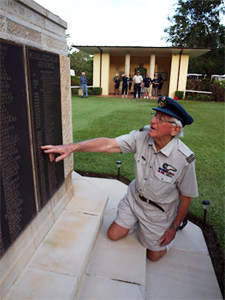
After brushing up on military history at the Darwin Military Museum, which unashamedly exhibits Japanese drop tanks, bombs, anti-submarine boom nets and other paraphernalia, I headed for the tracks.
A mixture of excitement and reverence kicked in joining Great Southern Rail’s special ANZAC tribute journey aboard The Ghan.
Australia’s most iconic train was named after the pioneering Afghan cameleers who traipsed the continent’s dusty deserts a century and a half ago. The ‘camel and handler’ emblem that ornaments the side of the train honors them.
From the station platform, the Palmerston City Concert Band performed ‘It’s a long way to Tipperary’. Then on we climbed, leaving the humidity of the tropics to perspiring tourists who enviously snapped photos as we began to chug south.
This ANZAC-themed trip was a slight variation from the twice-weekly train service between Darwin and Adelaide, to uniquely remember the fallen, and to acknowledge the Returned & Services League of Australia (www.rsl.org.au). The Ghan features various themes each year, but all journeys showcase the iconic Outback along Australia’s ancient spine.
Veterans and historians
At welcome drinks in the Explorer Lounge, we joined Dr. Tom Lewis, Darwin Military Museum’s director and guest historian on board, to answer any burning questions from war buffs. Also traveling with us was 91-year-old WWII wireless air gunner, Brian Winspear, Australia’s last surviving veteran caught up in both Japanese air raids on 19th February 1942.
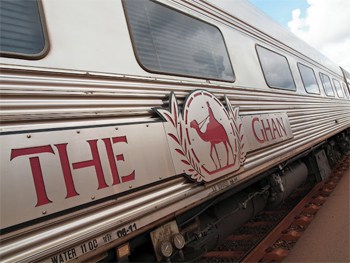
Brian told us how on that day in Darwin, he was due to board his plane but was replaced last minute. Our silence sharpened when Brian described how he watched the plane go up, with 12 on board, and nose-dive straight down.
“We were assessing the wreck,” said Brian, “when we saw more planes coming. ‘The Yanks are here thank goodness’ we’d said, but then we saw the sun reflecting off the bombs. They shone like confetti, straight overhead. So we put corks in our mouths, tin hats on our heads and got into the trench.”
It was the same Japanese fleet that took Pearl Harbor several weeks before.
Paying respects
Our first stop was for the Adelaide River War Cemetery. We arrived at The Last Post bugle call as soldiers rehearsed for the following morning’s ANZAC commemorations. The cemetery’s impeccably manicured lawns were lined with 434 military graves and 63 civilian graves headed by bronze plaques. The youngest fallen was Robert Stobo, just 16 years old.

The Northern Territory Memorial to the Missing at the center of the cemetery lists 293 servicemen with no known graves. It was a lump-in-the-throat moment as Brian pointed to 16 from his squadron.
Sentiments lightened after I asked Brian what was his secret to looking so healthy at 91. He replied with, “Well I only smoked once; a packet of State Express 333 the day after the first raid, but the true secret Marie,” he said, with an eye-wink, “is selecting your parents very carefully!”
Back on the station platform, stallholders sold their enticing local produce. I duly raided the Batchelor Bees honey stall. For health reasons of course!
Cultural blend
The sun deflated while an explosive bonfire inflated as we pulled into the outback township of Katherine, where the tropics and the outback unite. The flames illuminated a trackside performance by the Aboriginal dance troupe, The Bunggul Dancers, decorated in their ochre paints.
Next up was Australia’s highly revered singer/songwriter, John Schumann and his Vagabond Crew (also aboard The Ghan), formerly called Red Gum. They jammed with just two guitars, a violin, and lyrics recalling the hardships of war. When they sang their signature Vietnam veteran’s anthem: ‘I was only 19’, the cinders of the firelight flickered in the moistened eyes of the audience.
Dinner was devoured in the sumptuously decorated Queen Adelaide Restaurant carriage, with its paint-white tablecloths, cozy curtains, and miniature table lamps. We indulged on grain-fed beef, truffled polenta, braised capsicum, and roasted carrots. I also scoffed white chocolate gateaux to ease the blow of my upcoming 5.am alarm.
ANZAC Day
On 25th April, I was up before the sun, to be coached to Katherine Memorial for the ANZAC Day Dawn Service. Almost 100 bombs blighted this tiny township during the war. To a congregation of around 500, Mark Hagger of the Katherine RSL branch welcomed all. Hymns were sung as wreaths were laid for the fallen, followed by a minute’s silence.
The sun rose as the congregation began the Australian national anthem. Then across the road, we all marched to the local RSL club for a Gunfire Breakfast of sausages, bacon, eggs, beans, and tomatoes. Fed and watered, we then enjoyed another performance by John Schuman and crew.
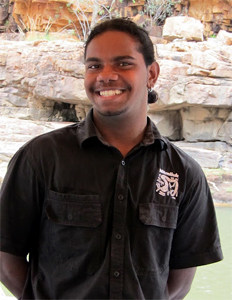
That afternoon, we headed for a cruise with Nitmiluk Tours, enjoying tea and homemade scones as we meandered along the Katherine River.
Dion, our indigenous guide, told us how the Jawoyn people, the area’s traditional owners, read climate patterns by way of the trees fruiting, and how animal behaviors change according to the seasons.
During the wet season, creeks and swamps regenerate, attracting wildlife, and the Katherine River fills with catfish and barramundi. Then when the flowers bloom, freshwater crocodiles lay their eggs. A baby crocodile then peeped up to monitor us, but sleekly submerged himself as cameras began clicking.
We snaked our way through labyrinthine Nitmiluk Gorge as rain drizzled down. But the luminescent sandstone escarpments, millions of years old, painted in orange iron oxide and green algae, shone down onto the freshwater, crocodile-inhabited Katherine River.
Only Trees
“Europeans see only ‘trees’,” said Dion, as he pointed out the region’s Eucalyptus Alba (white gum).“Indigenous people see their supermarket, their shelter, medicine, and tools. They chew on bark for toothache for example, and acacia trees are used for soap.” Bronchial laughter roared from the group when Dion then quipped: “Personally, I see only trees… but maybe that’s just me!”
Dion then asked if we’d noticed any ‘diarrhea mounds’ on our journey yet. Faces perplexed until he explained that termite mounds (which we’d seen from The Ghan) are made up of excreted dirt, saliva and poop.
Our indigenous skipper, Jamie, equally bursting with local knowledge, asked us to look out for the tiny sandstone shrike-thrush. It lives only here in the treetops. Alas, they were elusive that day.
Disembarking onto the riverbank, dotted with inquisitive wallabies, we were again treated to a concert by John’s band. This time, peppered with stories of their performances before troops in Afghanistan and Iraq. As if on cue, the heavens reopened.
A station near Alice

Excitement woke me long before my alarm on approach to Alice Springs. From bed, my window framed outback spinifex and that quintessentially red Australian soil. A burnished orange sunrise evaporated dew from the rusty desert sands and projected its heat onto the metal trims of my cabin like a flickering fireplace. Disembarking for our whistle-stop tour, I already understood how spiritual and raw Australia’s heart is.
A quick bus transfer led us to ‘The Camel Man, at the Pyndan Camel Tracks. A movie set-like scene unfolded, with a yard full of dromedaries belonging to Marcus Williams; surely, the real Crocodile Dundee. Marcus once wandered the outback deserts with his beloved camels, living in a sand dune with a freshwater well and lean-to.
The early Afghan cameleers first crossed Australia’s harsh interior when camels arrived on ships during the 1860s. They hauled rail tracks and supplies between townships. When motorized vehicles arrived, working camels were set free, and they proliferated spectacularly. There are around a million wild camels roaming Australia today.
Having got our legs over, we rode our ‘ships of the desert’ through White Gums Valley, to a backdrop of the textured MacDonnell Ranges. Contrasted under the royal-blue sky, they glowed in all shades of sun-scorched reds.
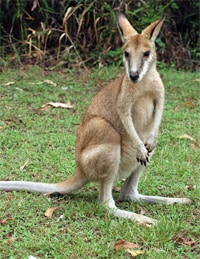
Each of our camels had charming personalities. Ours was called Greyhound, and was an ex-racing camel that featured in the movie Kangaroo Jack. Ruby, (in front of us) liked to snack on wattles mid-trek, causing Greyhound to nose-butt her from behind!
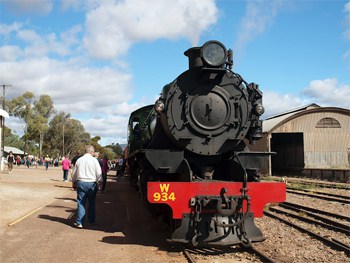
Our camel train plodded amid a 360-degree view of surprisingly green shrubs, with two juvenile kangaroos spying from them. The rhythmic sound of the camels’ feet brushing along the soil was all that broke the ripest outback silence.
Nature’s slideshow
Back on The Ghan, lunching on Northern Territory saltwater barramundi, the landscape changed as if through a sped-up time-lapse lens, yet the hypnotic horizon remained constant.
One minute, there were tall green trees, and the next, sparse knee-high saltbush. One window-frame captured emus drinking from waterholes. Another caught a mob of kangaroos bouncing away from the railway. And another met herds of Brahman cattle standing fearlessly, staring straight at us.
Later, there seemed to be no life whatsoever, just abandoned trucks and train carriages that stood decaying under the South Australian sun. We passed the Finke River, the world’s oldest at 30,000 years, and The Iron Man, a sculpture built by railway workers to mark the one-millionth concrete sleeper on the new railway line (the old wooden one was digested by termites).
Full steam ahead!
At Port Augusta, we piled off The Ghan and onto the charming, all-timber 1920s-built Pichi Richi. This historic steam train carried WWII troops on the old Ghan line, between Terowie and Oodnadatta and then Alice Springs. US General Douglas MacArthur’s famous ‘I came out of Bataan and I shall return’ statement was delivered by the front carriage of the train at Terowie in March 1942.
Today, the Pichi Richi is immaculately preserved with its sliding windows and sleeper-cabins with dropdown sinks and old-style faucets. I sat at the rear of the train, on an antique armchair in the quaint, curtained and carpeted Commissioner’s Carriage, originally reserved for government officials.
The nostalgic ride took us over ornate iron bridges through the Flinders Ranges, studded with majestic eucalypts. After reaching the summit at 1,332 meters above sea level, we chugged our way to Quorn.
We returned to The Ghan for the last time and journeyed on our final leg to Adelaide enjoying a sumptuous lunch of roasted breast of chicken with sweet potato, garlic, thyme, and macadamia nut butter dressing. The Flinders Ranges seamlessly blended into the brown and yellow agricultural plains and saltpans of South Australia.
The Ghan has 35 carriages, is 710 meters long, has two locomotives, four drivers and two chefs, weighs a hefty 1000 tons and covered a 2,979 km length of railway, all without one single time change. My memories of the journey, and of the notable characters I’d met along it, are immeasurable.
Further information:www.greatsouthernrail.com.au
Marie Barbieri’s work has appeared in numerous inflight magazines and newsstand titles to include: Asian Geographic Passport; Great Walks; Bicycling Australia; Luxury Travel & Style; Holidays for Couples; TNT; Australia & New Zealand; Italia and Wanderlust. She lives in South Australia.
Eurail Passes: What to Know about Buying a Europe Train Pass
- These 9 U.S. National Parks Require Reservations in 2024 - April 17, 2024
- Take a Hike in Olympic National Park - April 17, 2024
- The Wild Mississippi: 2340 Miles Across Ten States - April 8, 2024





